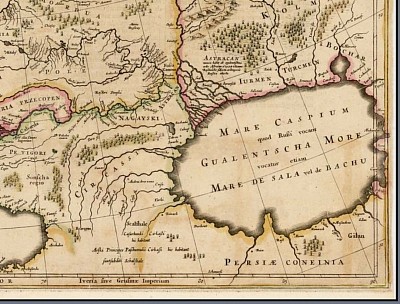Ancient Caucasus
Caucasus
The Caucasus and the Caspian Sea, located at the junction of Europe and Asia , have played an important political role for millennia, economic and cultural development of peoples and countries. The Caucasus-Caspian region was a convenient springboard for an offensive in the Middle East , Central Asia , India ... The main geopolitical role in this region was played by the Caucasus, bordered by the Black, Azov and Caspian Seas. The Caucasus was a military-strategic bridgehead for advancing access to the Eastern Mediterranean and Persian Gulf. Due to its geographic location, the Caucasus connected Eastern Europe with Western Asia. Through this region, there were routes from Central Asia to the Black Sea and the Mediterranean, from the Eurasian steppes to the Middle East. The Caucasus mountains served as a reliable barrier, enclosing the flat expanses of southern Russia from expansion from the South Caucasus - from the north.
On the western coast of the Caspian, where the Caucasus mountains come close to the sea, leaving only a narrow coastal strip, in ancient times the famous Caspian route ran - the most convenient road from South-Eastern Europe to Western Asia, connecting for many centuries the areas of nomads in the North Caucasus with areas of ancient agriculture in the South Caucasus. Since the Bronze Age, the warlike tribes of the Kipchaks rushed along it to the fertile agricultural centers of the south. The interactions of the Kipchaks of the North with the settled population of the East, nomads and farmers, which played such a great role in the history of the peoples of the Caucasus and Western Asia, were an essential element of the economic system of the Ancient World. The ancient Caucasus was a constant theater of political events: peoples of different races and different mixtures invaded from the south to the north and northwest, then from the north to the south and southeast, therefore the passages between the Caspian and the Black Seas did not know any rest from popular movements. For many centuries, ancient Iranian tribes from the steppes of Eastern Europe passed this way, the Scythians, Massagets, Sarmatians, Alans, Huns, Savirs, Khazars and many other nomadic tribes of the Eurasian steppes penetrated into the South Caucasus and Western Asia. During the period of the beginning of the Scythian invasion of Western Asia, already at the end of the 8th - early 7th centuries. BC. the fortress of Derbent with its powerful fortifications arose. In the writings of Herodotus (5th century BC), Strabo (1st century BC - 1st century AD), Pliny the Elder (1st century), Ptolemy (1st-2nd centuries) , Cassius Dion (II century) and other Greco-Roman historians and geographers contain information about the "Caspian gates". Through the Main Caucasian ridge - along the Darial passage in the VIII-VII centuries. BC. The tribes of the Cimmerians and Scythians , who lived in the North Caucasus, rushed southward, invading Assyria, Urartu and Media. Since the time of Homer, the Caucasus, the Caspian Sea and the Black Sea attracted the attention of the intellectual and military-political elite of the Ancient world. Assyrian cuneiforms during the reign of Adadnerari III (810–783 BC) refer to the Caspian as the “Great Sea of Sunrise”. Rumors about the untold riches of the Caucasus, apparently, served as the basis for the ancient Greek myth of the Argonauts who set off by sea to the distant and mysterious Colchis for the Golden Fleece. The legendary Homer believed that the Earth in the west stretches to the Atlantic Ocean, and in the east - to the "Pond of the Sun" - the Caspian Sea. According to the ancient Greek poet, "The Pond of the Sun is the bay of the deep and smoothly flowing world river of the Ocean." Already Herodotus in the 5th century. BC. possessed fairly reliable information about the size of the Caspian Sea, noting that it is a closed body of water, not connected with any other sea. Moreover, both Herodotus himself and later antique authors invariably emphasized the extremely variegated polyethnic nature of the "Land of the Mountains". “Many different tribes live in the Caucasus,” noted the “father of history” Herodotus. This information is also contained in the works of the ancient geographer Strabo (1st century BC - 1st century AD), historian Cornelius Tacitus (55-117) and other natural resources of the region, which was also a region versatile contacts between Eastern Europe and Western Asia, served as one of the important reasons and objects of the expansion of the ancient states of the Mediterranean. The gaze of Alexander the Great , Pompey , Caesar , Nero and other powerful people of this ancient West were fixed on the Caucasus and the Caspian. North Caucasus , from the IV century. BC. becomes the most important supplier of "oil of the Ancient World" - bread to Athens. In the middle of the 1st millennium BC. In the eastern and northern regions of the Caspian, there were tribes engaged in nomadic cattle breeding, which Herodotus and other ancient authors called Scythians, and in the Achaemenid cuneiform texts, Saks . The successors of the Saks were established in the III-II centuries. BC. tribal unions of Usuns who occupied the territory of Semirechye , tribes that were part of the state formation Kanchuy, settled in the regions of Karatau and the middle reaches of the Syr Darya, as well as the tribes of Alans who roamed from the western shores of the Aral to the northern shores of the Caspian seas. These tribes had economic, political and cultural ties with China, Maverannahr, the Volga region. Caravans passed through the lands of the Usuns along one of the branches of the Great Silk Road. On the territory of modern Turkmenistan in the middle of the 1st millennium BC. the most economically developed were Margiana and Parthia. On the southeastern coast of the Caspian Sea was the region of Hyrcania, and to the north, in the steppes, inhabited the nomadic tribes of the Massagetae and Dakhs. B VII-VI centuries. BC. Margiana was part of Bactria, and Parthia and Hyrcania were part of the Median state . B VI-V centuries. BC. these territories were already part of the Achaemenid Empire. Subsequently, after the conquests of Alexander the Great , Parthia first established their control over these territories , and from the 3rd century. - Sassanids. Meanwhile, having withstood the onslaught of the tellurocratic continental forces of the East in the person of the Achaemenid Empire in the long Greco-Persian wars (495-449 BC), thanks to the most powerful fleet at that time, the Hellenistic West began a counteroffensive in a little over a hundred years. eastward, lasting several centuries ...


